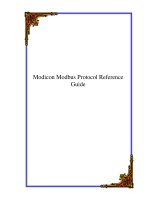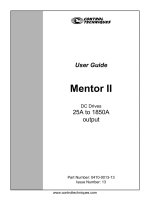Manga guide calculus hiroyuki kojima
Bạn đang xem bản rút gọn của tài liệu. Xem và tải ngay bản đầy đủ của tài liệu tại đây (29.17 MB, 259 trang )
www.pdfgrip.com
Praise for the Manga Guide series
“Highly recommended.”
— choice magazine
“Stimulus for the next generation of scientists.”
— scientific computing
“A great fit of form and subject. Recommended.”
— otaku usa magazine
“The art is charming and the humor engaging. A fun and fairly painless
lesson on what many consider to be a less-than-thrilling subject.”
— school library journal
“This is really what a good math text should be like. Unlike the majority of
books on subjects like statistics, it doesn’t just present the material as a
dry series of pointless-seeming formulas. It presents statistics as something fun, and something enlightening.”
— good math, bad math
“I found the cartoon approach of this book so
compelling and its story so endearing that I
recommend that every teacher of introductory
physics, in both high school and college, consider using [The Manga Guide to Physics].”
—american journal of physics
“A single tortured cry will escape the lips of
every thirty-something biochem major who
sees The Manga Guide to Molecular Biology:
‘Why, oh why couldn’t this have been written
when I was in college?’”
— the san francisco examiner
“A lot of fun to read. The interactions between
the characters are lighthearted, and the whole
setting has a sort of quirkiness about it that
makes you keep reading just for the joy of it.”
—hack a day
“The Manga Guide to Databases was the most
enjoyable tech book I’ve ever read.”
—rikki kite, linux pro magazine
www.pdfgrip.com
Wow!
www.pdfgrip.com
The Manga Guide™ to Calculus
www.pdfgrip.com
∫
d
www.pdfgrip.com
The Manga Guide™ to
Calculus
Hiroyuki Kojima
Shin Togami
Becom Co., Ltd.
www.pdfgrip.com
The Manga Guide to Calculus. Copyright © 2009 by Hiroyuki Kojima and Becom Co., Ltd
The Manga Guide to Calculus is a translation of the Japanese original, Manga de Wakaru
Bibun Sekibun, published by Ohmsha, Ltd. of Tokyo, Japan, © 2005 by Hiroyuki Kojima and
Becom Co., Ltd.
This English edition is co-published by No Starch Press and Ohmsha, Ltd.
All rights reserved. No part of this work may be reproduced or transmitted in any form or by any
means, electronic or mechanical, including photocopying, recording, or by any information storage
or retrieval system, without the prior written permission of the copyright owner and the publisher.
17 16 15 14 5 6 7 8 9
ISBN-10: 1-59327-194-8
ISBN-13: 978-1-59327-194-7
Publisher: William Pollock
Author: Hiroyuki Kojima
Illustrator: Shin Togami
Producer: Becom Co., Ltd.
Production Editor: Megan Dunchak
Developmental Editor: Tyler Ortman
Technical Reviewers: Whitney Ortman-Link and Erika Ward
Compositor: Riley Hoffman
Proofreader: Cristina Chan
Indexer: Sarah Schott
For information on book distributors or translations, please contact No Starch Press, Inc. directly:
No Starch Press, Inc.
245 8th Street, San Francisco, CA 94103
phone: 415.863.9900; ; />Library of Congress Cataloging-in-Publication Data
Kojima, Hiroyuki, 1958[Manga de wakaru bibun sekibun. English]
The manga guide to calculus / Hiroyuki Kojima, Shin Togami, and Becom Co., Ltd.
p. cm.
Includes index.
ISBN-13: 978-1-59327-194-7
ISBN-10: 1-59327-194-8
1. Calculus--Comic books, strips, etc. I. Togami, Shin. II. Becom Co. III. Title.
QA300.K57513 2009
515--dc22
2008050189
No Starch Press and the No Starch Press logo are registered trademarks of No Starch Press, Inc.
Other product and company names mentioned herein may be the trademarks of their respective owners. Rather than use a trademark symbol with every occurrence of a trademarked name, we are using
the names only in an editorial fashion and to the benefit of the trademark owner, with no intention of
infringement of the trademark.
The information in this book is distributed on an “As Is” basis, without warranty. While every precaution has been taken in the preparation of this work, neither the author nor No Starch Press, Inc.
shall have any liability to any person or entity with respect to any loss or damage caused or alleged
to be caused directly or indirectly by the information contained in it.
All characters in this publication are fictitious, and any resemblance to real persons, living or dead,
is purely coincidental.
www.pdfgrip.com
Contents
Preface . . . . . . . . . . . . . . . . . . . . . . . . . . . . . . . . . . . . . . . . . . . . . . . . . . . . . . . . xi
Prologue:
What Is A Function? . . . . . . . . . . . . . . . . . . . . . . . . . . . . . . . . . . . . . . . . . . . . 1
Exercise . . . . . . . . . . . . . . . . . . . . . . . . . . . . . . . . . . . . . . . . . . . . . . . . . . . . . . . . 14
1
Let’s Differentiate a Function! . . . . . . . . . . . . . . . . . . . . . . . . . . . . . . . . . 15
Approximating with Functions . . . . . . . . . . . . . . . . . . . . . . . . . . . . . . . . . . . . . . 16
Calculating the Relative Error . . . . . . . . . . . . . . . . . . . . . . . . . . . . . . . . . . . . . . 27
The Derivative in Action! . . . . . . . . . . . . . . . . . . . . . . . . . . . . . . . . . . . . . . . . . . 32
Step 1 . . . . . . . . . . . . . . . . . . . . . . . . . . . . . . . . . . . . . . . . . . . . . . . . . . . . . . 34
Step 2 . . . . . . . . . . . . . . . . . . . . . . . . . . . . . . . . . . . . . . . . . . . . . . . . . . . . . . 34
Step 3 . . . . . . . . . . . . . . . . . . . . . . . . . . . . . . . . . . . . . . . . . . . . . . . . . . . . . . 35
Calculating the Derivative . . . . . . . . . . . . . . . . . . . . . . . . . . . . . . . . . . . . . . . . . . 39
Calculating the Derivative of a Constant, Linear,
or Quadratic Function . . . . . . . . . . . . . . . . . . . . . . . . . . . . . . . . . . . . . . 40
Summary . . . . . . . . . . . . . . . . . . . . . . . . . . . . . . . . . . . . . . . . . . . . . . . . . . . . . . . 40
Exercises . . . . . . . . . . . . . . . . . . . . . . . . . . . . . . . . . . . . . . . . . . . . . . . . . . . . . . . 41
2
Let’s Learn Differentiation Techniques! . . . . . . . . . . . . . . . . . . . . . . . . 43
The Sum Rule of Differentiation . . . . . . . . . . . . . . . . . . . . . . . . . . . . . . . . . . . . 48
The Product Rule of Differentiation . . . . . . . . . . . . . . . . . . . . . . . . . . . . . . . . . . 53
Differentiating Polynomials . . . . . . . . . . . . . . . . . . . . . . . . . . . . . . . . . . . . . . . . 62
Finding Maxima and Minima . . . . . . . . . . . . . . . . . . . . . . . . . . . . . . . . . . . . . . . . 64
Using the Mean Value Theorem . . . . . . . . . . . . . . . . . . . . . . . . . . . . . . . . . . . . . 72
Using the Quotient Rule of Differentiation . . . . . . . . . . . . . . . . . . . . . . . . . . . . 74
Calculating Derivatives of Composite Functions . . . . . . . . . . . . . . . . . . . . . . . . 75
Calculating Derivatives of Inverse Functions . . . . . . . . . . . . . . . . . . . . . . . . . . . 75
Exercises . . . . . . . . . . . . . . . . . . . . . . . . . . . . . . . . . . . . . . . . . . . . . . . . . . . . . . . 76
3
Let’s Integrate a Function! . . . . . . . . . . . . . . . . . . . . . . . . . . . . . . . . . . . . 77
Illustrating the Fundamental Theorem of Calculus . . . . . . . . . . . . . . . . . . . . . . 82
Step 1—When the Density Is Constant . . . . . . . . . . . . . . . . . . . . . . . . . . . . 83
Step 2—When the Density Changes Stepwise . . . . . . . . . . . . . . . . . . . . . . . 84
Step 3—When the Density Changes Continuously . . . . . . . . . . . . . . . . . . . 85
Step 4—Review of the Imitating Linear Function . . . . . . . . . . . . . . . . . . . . 88
Step 5—Approximation Exact Value . . . . . . . . . . . . . . . . . . . . . . . . . . . . 89
Step 6—p(x) Is the Derivative of q(x) . . . . . . . . . . . . . . . . . . . . . . . . . . . . . . 90
www.pdfgrip.com
Using the Fundamental Theorem of Calculus . . . . . . . . . . . . . . . . . . . . . . . . . . 91
Summary . . . . . . . . . . . . . . . . . . . . . . . . . . . . . . . . . . . . . . . . . . . . . . . . . . . 93
A Strict Explanation of Step 5 . . . . . . . . . . . . . . . . . . . . . . . . . . . . . . . . . . . 94
Using Integral Formulas . . . . . . . . . . . . . . . . . . . . . . . . . . . . . . . . . . . . . . . . 95
Applying the Fundamental Theorem . . . . . . . . . . . . . . . . . . . . . . . . . . . . . . . . 101
Supply Curve . . . . . . . . . . . . . . . . . . . . . . . . . . . . . . . . . . . . . . . . . . . . . . . 102
Demand Curve . . . . . . . . . . . . . . . . . . . . . . . . . . . . . . . . . . . . . . . . . . . . . . 103
Review of the Fundamental Theorem of Calculus . . . . . . . . . . . . . . . . . . . . . . 110
Formula of the Substitution Rule of Integration . . . . . . . . . . . . . . . . . . . . . . . 111
The Power Rule of Integration . . . . . . . . . . . . . . . . . . . . . . . . . . . . . . . . . . . . . 112
Exercises . . . . . . . . . . . . . . . . . . . . . . . . . . . . . . . . . . . . . . . . . . . . . . . . . . . . . . 113
4
Let’s Learn Integration Techniques! . . . . . . . . . . . . . . . . . . . . . . . . . . 115
Using Trigonometric Functions . . . . . . . . . . . . . . . . . . . . . . . . . . . . . . . . . . . . 116
Using Integrals with Trigonometric Functions . . . . . . . . . . . . . . . . . . . . . . . . 125
Using Exponential and Logarithmic Functions . . . . . . . . . . . . . . . . . . . . . . . . 131
Generalizing Exponential and Logarithmic Functions . . . . . . . . . . . . . . . 135
Summary of Exponential and Logarithmic Functions . . . . . . . . . . . . . . . . . . . 140
More Applications of the Fundamental Theorem . . . . . . . . . . . . . . . . . . . . . . . 142
Integration by Parts . . . . . . . . . . . . . . . . . . . . . . . . . . . . . . . . . . . . . . . . . . 143
Exercises . . . . . . . . . . . . . . . . . . . . . . . . . . . . . . . . . . . . . . . . . . . . . . . . . . . . . . 144
5
Let’s Learn About Taylor Expansions! . . . . . . . . . . . . . . . . . . . . . . . . . 145
Imitating with Polynomials . . . . . . . . . . . . . . . . . . . . . . . . . . . . . . . . . . . . . . . . 147
How to Obtain a Taylor Expansion . . . . . . . . . . . . . . . . . . . . . . . . . . . . . . . . . . 155
Taylor Expansion of Various Functions . . . . . . . . . . . . . . . . . . . . . . . . . . . . . . 160
What Does Taylor Expansion Tell Us? . . . . . . . . . . . . . . . . . . . . . . . . . . . . . . . 161
Exercises . . . . . . . . . . . . . . . . . . . . . . . . . . . . . . . . . . . . . . . . . . . . . . . . . . . . . . 178
6
Let’s Learn About Partial Differentiation! . . . . . . . . . . . . . . . . . . . . . 179
What Are Multivariable Functions? . . . . . . . . . . . . . . . . . . . . . . . . . . . . . . . . . 180
The Basics of Variable Linear Functions . . . . . . . . . . . . . . . . . . . . . . . . . . . . . 184
Partial Differentiation . . . . . . . . . . . . . . . . . . . . . . . . . . . . . . . . . . . . . . . . . . . . 191
Definition of Partial Differentiation . . . . . . . . . . . . . . . . . . . . . . . . . . . . . . 196
Total Differentials . . . . . . . . . . . . . . . . . . . . . . . . . . . . . . . . . . . . . . . . . . . . . . . 197
Conditions for Extrema . . . . . . . . . . . . . . . . . . . . . . . . . . . . . . . . . . . . . . . . . . 199
Applying Partial Differentiation to Economics . . . . . . . . . . . . . . . . . . . . . . . . 202
The Chain Rule . . . . . . . . . . . . . . . . . . . . . . . . . . . . . . . . . . . . . . . . . . . . . . . . . 206
Derivatives of Implicit Functions . . . . . . . . . . . . . . . . . . . . . . . . . . . . . . . . . . . 218
Exercises . . . . . . . . . . . . . . . . . . . . . . . . . . . . . . . . . . . . . . . . . . . . . . . . . . . . . . 218
viii Contents
www.pdfgrip.com
Epilogue:
What Is Mathematics for? . . . . . . . . . . . . . . . . . . . . . . . . . . . . . . . . . . . . 219
A
Solutions to Exercises . . . . . . . . . . . . . . . . . . . . . . . . . . . . . . . . . . . . . . 225
Prologue . . . . . . . . . . . . . . . . . . . . . . . . . . . . . . . . . . . . . . . . . . . . . . . . . . . . . . 225
Chapter 1 . . . . . . . . . . . . . . . . . . . . . . . . . . . . . . . . . . . . . . . . . . . . . . . . . . . . . . 225
Chapter 2 . . . . . . . . . . . . . . . . . . . . . . . . . . . . . . . . . . . . . . . . . . . . . . . . . . . . . . 225
Chapter 3 . . . . . . . . . . . . . . . . . . . . . . . . . . . . . . . . . . . . . . . . . . . . . . . . . . . . . . 226
Chapter 4 . . . . . . . . . . . . . . . . . . . . . . . . . . . . . . . . . . . . . . . . . . . . . . . . . . . . . . 227
Chapter 5 . . . . . . . . . . . . . . . . . . . . . . . . . . . . . . . . . . . . . . . . . . . . . . . . . . . . . . 228
Chapter 6 . . . . . . . . . . . . . . . . . . . . . . . . . . . . . . . . . . . . . . . . . . . . . . . . . . . . . . 229
B
Main Formulas, Theorems, and Functions
Covered in this Book . . . . . . . . . . . . . . . . . . . . . . . . . . . . . . . . . . . . . . . . . 231
Linear Equations (Linear Functions) . . . . . . . . . . . . . . . . . . . . . . . . . . . . . . . . 231
Differentiation . . . . . . . . . . . . . . . . . . . . . . . . . . . . . . . . . . . . . . . . . . . . . . . . . . 231
Derivatives of Popular Functions . . . . . . . . . . . . . . . . . . . . . . . . . . . . . . . . . . . 232
Integrals . . . . . . . . . . . . . . . . . . . . . . . . . . . . . . . . . . . . . . . . . . . . . . . . . . . . . . 233
Taylor Expansion . . . . . . . . . . . . . . . . . . . . . . . . . . . . . . . . . . . . . . . . . . . . . . . 234
Partial Derivatives . . . . . . . . . . . . . . . . . . . . . . . . . . . . . . . . . . . . . . . . . . . . . . . 234
Index . . . . . . . . . . . . . . . . . . . . . . . . . . . . . . . . . . . . . . . . . . . . . . . . . . . . . . . . 235
Contents ix
www.pdfgrip.com
www.pdfgrip.com
Preface
There are some things that only manga can do.
You have just picked up and opened this book. You must be
one of the following types of people.
The first type is someone who just loves manga and thinks,
“Calculus illustrated with manga? Awesome!” If you are this type
of person, you should immediately take this book to the cashier—
you won’t regret it. This is a very enjoyable manga title. It’s no
surprise—Shin Togami, a popular manga artist, drew the manga,
and Becom Ltd., a real manga production company, wrote the
scenario.
“But, manga that teaches about math has never been very
enjoyable,” you may argue. That’s true. In fact, when an editor at
Ohmsha asked me to write this book, I nearly turned down the
opportunity. Many of the so-called “manga for education” books
are quite disappointing. They may have lots of illustrations and
large pictures, but they aren’t really manga. But after seeing a
sample from Ohmsha (it was The Manga Guide to Statistics), I
totally changed my mind. Unlike many such manga guides, the
sample was enjoyable enough to actually read. The editor told me
that my book would be like this, too—so I accepted his offer. In
fact, I have often thought that I might be able to teach mathematics better by using manga, so I saw this as a good opportunity to
put the idea into practice. I guarantee you that the bigger manga
freak you are, the more you will enjoy this book. So, what are you
waiting for? Take it up to the cashier and buy it already!
Now, the second type of person is someone who picked up this
book thinking, “Although I am terrible at and/or allergic to calculus, manga may help me understand it.” If you are this type of person, then this is also the book for you. It is equipped with various
rehabilitation methods for those who have been hurt by calculus
in the past. Not only does it explain calculus using manga, but
the way it explains calculus is fundamentally different from the
method used in conventional textbooks. First, the book repeatedly
www.pdfgrip.com
presents the notion of what calculus really does. You will never
understand this through the teaching methods that stick to limits
(or ε-δ logic). Unless you have a clear image of what calculus really
does and why it is useful in the world, you will never really understand or use it freely. You will simply fall into a miserable state of
memorizing formulas and rules. This book explains all the formulas based on the concept of the first-order approximation, helping
you to visualize the meaning of formulas and understand them
easily. Because of this unique teaching method, you can quickly
and easily proceed from differentiation to integration. Furthermore, I have adopted an original method, which is not described in
ordinary textbooks, of explaining the differentiation and integration of trigonometric and exponential functions—usually, this is
all Greek to many people even after repeated explanations. This
book also goes further in depth than existing manga books on
calculus do, explaining even Taylor expansions and partial differentiation. Finally, I have invited three regular customers of
calculus—physics, statistics, and economics—to be part of this
book and presented many examples to show that calculus is truly
practical. With all of these devices, you will come to view calculus
not as a hardship, but as a useful tool.
I would like to emphasize again: All of this has been made
possible because of manga. Why can you gain more information
by reading a manga book than by reading a novel? It is because
manga is visual data presented as animation. Calculus is a branch
of mathematics that describes dynamic phenomena—thus, calculus is a perfect concept to teach with manga. Now, turn the pages
and enjoy a beautiful integration of manga and mathematics.
Hiroyuki Kojima
November 2005
Note: For ease of understanding, some figures are not drawn
to scale.
xii Preface
www.pdfgrip.com
Prologue:
What Is A Function?
www.pdfgrip.com
The Asagake
Times’s Sanda-cho
Office must be
around here.
Just think — me,
Noriko Hikima, a
journalist! My
career starts
here!
It’s a small
newspaper and
just a branch
office. But I’m
still a journalist!
2 Prologue
www.pdfgrip.com
I’ll work
hard!!
The Asagake Times
Sanda-Cho Distributor
Sanda-cho Office...
do I have the
wrong map?
A newspaper
distributor?
It’s next
door.
You’re looking
for the Sanda-cho
branch office?
Everybody mistakes
us for the office
because we are
larger.
What Is a Function? 3
www.pdfgrip.com
The Asagake Times
Sanda-Cho Branch Office
Whoosh
Oh, no!!
It’s a prefab!
It’s a branch
office, but it’s
still the real
Asagake Times.
Don’t...don’t get
upset, Noriko.
4 Prologue
www.pdfgrip.com
Good
morning!
Here goes
nothing!
F li n g
z
zzz
z
z
Z
...
Lunch
delivery?
I’m dea---d.
What Is a Function? 5
www.pdfgrip.com
Will you
leave it,
please?
Wait, what?
I’m Noriko
Hikima.
The big guy there
is Futoshi Masui,
my only soldier.
Oh, you have
been assigned
here today.
Long trip,
wasn’t it? I’m
Kakeru Seki, the
head of this
office.
6 Prologue
www.pdfgrip.com
Just
two of
them...
Thinking...?
This is a good
place. A perfect
environment for
thinking about
things.
Yes! Thinking
about facts.
A fact is somehow
related to
another fact.
Unless you understand
these relationships,
you won’t be a real
reporter.
True journalism!!
What Is a Function? 7
www.pdfgrip.com
Well, you
majored in the
humanities.
Yes! That’s
true—I’ve studied
literature since
I was a junior in
high school.
You have a lot of
catching up to do,
then. Let’s begin
with functions.
When one thing
changes, it influences
another thing.
A function is a
correlation.
Fu...functions?
Math? What?
A function describes a
relation, causality, or
change.
You can think of
the world itself as
one big function.
As journalists,
our job is to find
the reason why
things happen—
the causality.
Yes...
www.pdfgrip.com
Did you know a
function is often
expressed as
y = f(x)?
For example,
assume x
and y are
animals.
Nope!!
Animal x
Assume x is a frog. If
you put the frog into
box f and convert it,
tadpole y comes out
of the box.
f
Animal y
But, uh...
what is f ?
f is used to show that
the variable y has a
The f stands for
function, naturally.
particular relationship
to x.
And we can
actually use any
letter instead
of f.
What Is a Function? 9
www.pdfgrip.com
In this case, f
expresses the
relationship
or rule
between
“a parent”
and “an
offspring.”
A parent
An offspring
And this
relationship is
true of almost
any animal. If x
is a bird, y is a
chick.
Okay! Now
look at this.
Cav iar
Sales
Down
g
Durin on
si
Reces
For example,
the relationship
between incomes
and expenditures
can be seen as a
function.
Jet
m
a
r
Sc
9.6 —
X-43 es Mach rd
o
h
Reac orld Rec
W
New
The speed of sound
and the temperature
can also be expressed
as a function. When
the temperature goes
up by 1°C, the speed
of sound goes up by
0.6 meters/second.
Like how when
the sales at a
company go up,
the employees
get bonuses?
o-
Yoo o !
h
10 Prologue
www.pdfgrip.com
And the
temperature in the
mountains goes
down by about
0.5°C each time you
go up 100 meters,
doesn’t it?
Do you get it? We
are surrounded by
functions.
We have plenty
of time here to
think about these
things quietly.
The things you
think about here
may become useful
someday.
I see what
you mean!
It’s a small
office, but I hope
you will do your
best.
Yes...
I will.
!
p
m
o
Pl
Whoa!
What Is a Function? 11
www.pdfgrip.com









